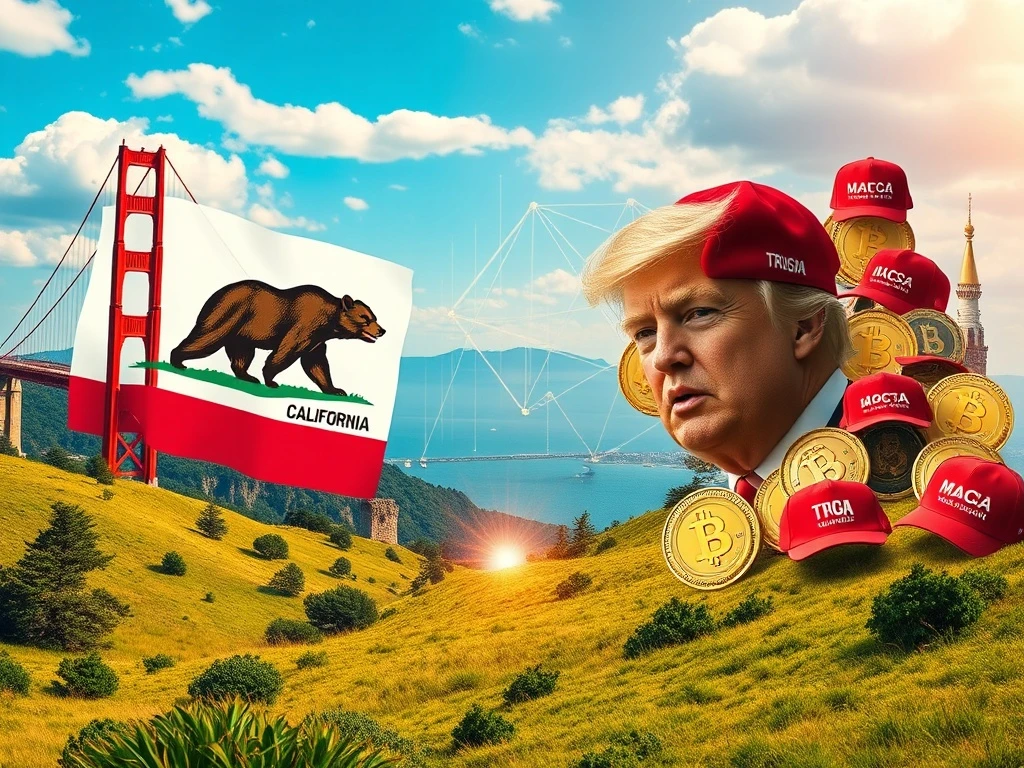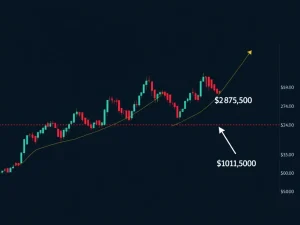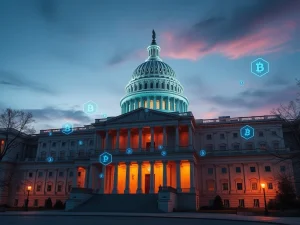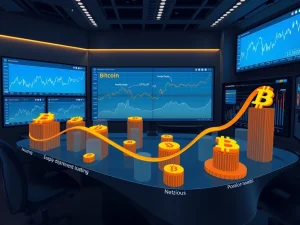Explosive Clash: Political Memecoins, California Crypto Regulation, and the Trump Token Phenomenon

The cryptocurrency landscape constantly evolves. Today, a new and often volatile sector demands attention: **political memecoins**. These tokens blur the lines between satire, fandom, and speculative investment. They ignite passionate debate, particularly as the 2025 election cycle intensifies. Furthermore, the robust regulatory environment in California now directly confronts this burgeoning, unpredictable market. Consequently, a fascinating battle unfolds between the free-wheeling nature of meme culture and the structured demands of state law. This article explores the dynamic interplay between these forces, specifically focusing on the **Trump token** and the proactive stance taken by Governor **Gavin Newsom crypto** policies.
The Rise of Political Memecoins in 2025
Political memecoins are digital tokens themed around real-world politicians or electoral campaigns. They often trade on narrative strength rather than inherent utility. Community sentiment, therefore, drives their value, especially during major election cycles. Many of these tokens launch on popular blockchains like Solana or Ethereum. Platforms such as Pump.fun simplify the creation process. This ease of access allows thousands of short-lived tokens to appear rapidly.
In 2025, this category truly blurs traditional boundaries. It combines elements of satire, devoted fandom, and what some traders mistakenly interpret as official endorsements. A prime example remains the Official Trump (TRUMP) token on Solana. This asset was presented as a meme tied to Donald Trump’s public image. It was not a financial contract in the traditional sense. However, the 2024 surge in a separate “DJT token” clearly demonstrated the inherent risks. Speculation spread quickly on rumors of campaign backing. These claims later proved unverified. This incident underscored how rapidly unverified assertions can move markets, often leading to significant investor losses. Consequently, understanding the speculative nature of these assets is crucial for any participant.
Did you know? During the 2024 US election cycle, crypto-linked political action committees (PACs) spent over $130 million on congressional races. Coinbase emerged as the largest single contributor, highlighting crypto’s growing influence in traditional politics.
Unpacking Trump’s Crypto Footprint and Volatility
Donald Trump’s presence in the crypto space has been shaped by several distinct projects. What remains consistently evident across all of them is extreme volatility. Investors should always prioritize primary disclosures. Verifiable on-chain addresses are also essential. These steps help distinguish genuine marketing from unconfirmed facts.
1. The TRUMP Token (Solana)
This token launched just before the 2025 inauguration. It quickly reached multi-billion dollar valuations. It became an integral part of Trump-branded marketing efforts. Furthermore, it offered perks like VIP dinners and exclusive merchandise. These promotions certainly helped drive visibility. However, they also contributed to sharp and unpredictable price swings. The **Trump token** became a focal point for both supporters and speculators, often reacting intensely to political news cycles.
2. The DJT Rumor Cycle (2024)
A separate Solana token, known as DJT, surged dramatically. This surge stemmed from intense speculation about ties to the Trump family. It then collapsed once these claims proved unverified. There were no on-chain links or official campaign statements to confirm any backing. Therefore, this event serves as a stark warning. It cautions against trading solely on unsubstantiated narratives. Such situations often leave investors vulnerable to rapid market shifts and significant losses.
3. World Liberty Financial’s WLFI (2025)
Trading for WLFI opened early in September. It saw heavy volume and rapid price movements from the outset. Media reports suggested the Trump family held nearly a quarter of the total supply. However, specific details on token lockups and distribution policies remained unclear. The token debuted at approximately $0.30. It then slid into the low $0.20s before partially recovering. This price action resembled a highly volatile listing rather than a stable, predictable asset. Investors, therefore, must exercise extreme caution when dealing with such assets.
Did you know? At the peak of the 2024 DJT rumor cycle, more than 200 Trump-branded tokens appeared. These tokens launched across Solana, BNB Chain, and Ethereum within a single week. This proliferation highlights the ease of creation and the speculative frenzy surrounding political figures in crypto.
California’s Digital Financial Assets Law (DFAL) Takes Center Stage
California’s proactive stance on digital assets is clear. The Digital Financial Assets Law (DFAL) forms a robust regulatory framework. This law was established through Assembly Bill 39 and Senate Bill 401. It creates comprehensive licensing and compliance requirements. These apply to firms offering digital asset services to state residents. Covered activities broadly include exchange, transfer, and custodial services. The state aims to protect consumers and ensure market integrity. Consequently, businesses operating in this space must adapt to these new rules.
The compliance deadline for DFAL was initially set for July 1, 2025. However, Assembly Bill 1934 extended this crucial date. The new start date is now July 1, 2026. This extension provides businesses with more time. They can now properly apply for licenses or seek applicable exemptions. This adjustment acknowledges the complexity of implementing such a broad regulatory framework. Nevertheless, the state’s Department of Financial Protection and Innovation (DFPI) has already demonstrated its intent. It plans to enforce these rules vigorously.
On June 25, 2025, the DFPI issued its first action under DFAL. This significant move involved a consent order against Coinme. The settlement included a substantial $300,000 penalty. It also mandated $51,700 in restitution. This action sends a clear signal. Companies dealing with Californians will be held accountable. They must adhere to the state’s rigorous standards. Therefore, the impact of **California crypto regulation** is undeniable.
For **political memecoins** and the platforms listing them, this means DFAL could apply directly. This is true if California users are involved in any capacity. Licensing requirements, truthful marketing, and robust consumer protection standards all fall under the DFPI’s reach. Marketplaces, promoters, and liquidity providers should anticipate further guidance. However, they must also assume real compliance duties. This applies if their services touch the state’s residents. The **DFAL law** fundamentally changes the operating environment for crypto businesses within California.
Gavin Newsom Crypto Stance and the ‘Trump Corruption Coin’ Tease
At Politico’s Sacramento Summit in late August, California Governor **Gavin Newsom crypto** ideas surfaced. He notably floated the concept of a “Trump Corruption Coin.” Newsom explicitly described this idea as satire. He positioned it alongside parody campaign merchandise. Furthermore, he framed it as a pointed jab at Trump’s embrace of crypto-themed branding. No actual contract, blockchain, or launch timeline for this satirical token exists. Newsom consistently emphasized that the idea served as political commentary. It was not a proposal for a real digital asset. This distinction is crucial for understanding his intent.
This move perfectly aligns with Newsom’s broader messaging. He has consistently argued that Trump’s political style undermines democratic norms. These norms include free and fair elections, along with the rule of law. By leaning on meme-driven tactics, Newsom mirrors Trump’s online communication style. At the same time, he attempts to turn the message directly against him. This strategy reflects a modern approach to political discourse. It leverages digital culture for impactful commentary. Ultimately, it highlights the growing intersection of politics and digital assets, even in a satirical context.
Did you know? Satirical currencies are not a new phenomenon. During the French Revolution, for instance, locals circulated “assignat” notes. These notes often featured mocking slogans targeting political rivals. This historical context shows a long tradition of using currency as a medium for political commentary.
Navigating the Volatile Landscape: A Trader’s Checklist for Political Memecoins
Political tokens are primarily story-driven assets. Therefore, traders must approach them with extra caution. A practical strategy involves running a quick checklist before engaging in any trading activity. This due diligence can mitigate significant risks. Consequently, informed decisions become paramount in this highly speculative market.
1. Authenticity and Verifiable Links
Always confirm whether a verifiable “official” link exists. This could be a campaign statement or a signed wallet. A contract published through known, reputable accounts also counts. The 2024 DJT case clearly showed how prices can surge dramatically on speculation. They then collapse once denials or on-chain facts emerge. Cross-check headlines against primary sources. Always consult block explorers for factual data. This critical step helps avoid misinformation.
2. Contract and Liquidity Controls
Thoroughly review who controls the token contract. Has ownership been formally renounced? Are upgrade keys secured by a multi-signature wallet? Is liquidity locked, and for what duration? Are large treasury or insider wallets transparent? Do they have clear, publicly stated policies? These are basic but vital checks. Auditors frequently highlight these points in their assessments. They provide crucial insights into a project’s security and trustworthiness.
3. Market Structure and Trading Patterns
Examine where the token trades. Assess its overall liquidity. Major centralized exchanges differ significantly from thin decentralized exchange (DEX) pools. A concentrated holder base or suspicious trading patterns may indicate market manipulation. Compliance firms have frequently flagged this risk across various Solana meme markets. Understanding the market’s underlying structure is key to identifying potential pitfalls.
4. Branding and Impersonation Risks
High-profile figures inevitably attract copycats. They also inspire look-alike tokens. These can easily confuse potential buyers. Always verify the provenance of a token. Never assume affiliation without concrete evidence. Even tokens marketed as “official,” like the **Trump token**, are still assessed through a rigorous risk lens by compliance analysts. Diligence in this area protects against scams and misrepresentation.
The Road Ahead: What to Watch in California Crypto Regulation and Political Memecoins
Political memecoins will likely remain highly volatile. Their prices will continue to be closely tied to headlines throughout the election cycle. Therefore, market participants should anticipate rapid shifts. California, meanwhile, will play an increasingly active role in this space. While **DFAL law** licensing requirements officially begin in July 2026, the DFPI is already enforcing its rules. Its June 25 action against Coinme, notably the first DFAL case, clearly indicates that scrutiny is well underway. This early enforcement shows a proactive regulatory approach.
For both traders and policy watchers, three key areas merit continuous attention:
- **DFPI guidance and rulemaking updates:** New directives could significantly impact how crypto businesses operate within California.
- **Gavin Newsom crypto ideas:** Any concrete details on whether his “Trump Corruption Coin” concept evolves beyond satire will be noteworthy.
- **Trump-linked tokens:** Assets such as WLFI and the original **Trump token** will continue to see price action. This often shifts dramatically within hours of relevant news coverage.
Ultimately, political tokens are high-risk, narrative-first assets. Always verify any “official” claims through on-chain provenance. Assume that California will continue tightening expectations for disclosures, licensing, and promotional activities. Staying informed and exercising extreme caution are essential for navigating this complex and often unpredictable market segment.






